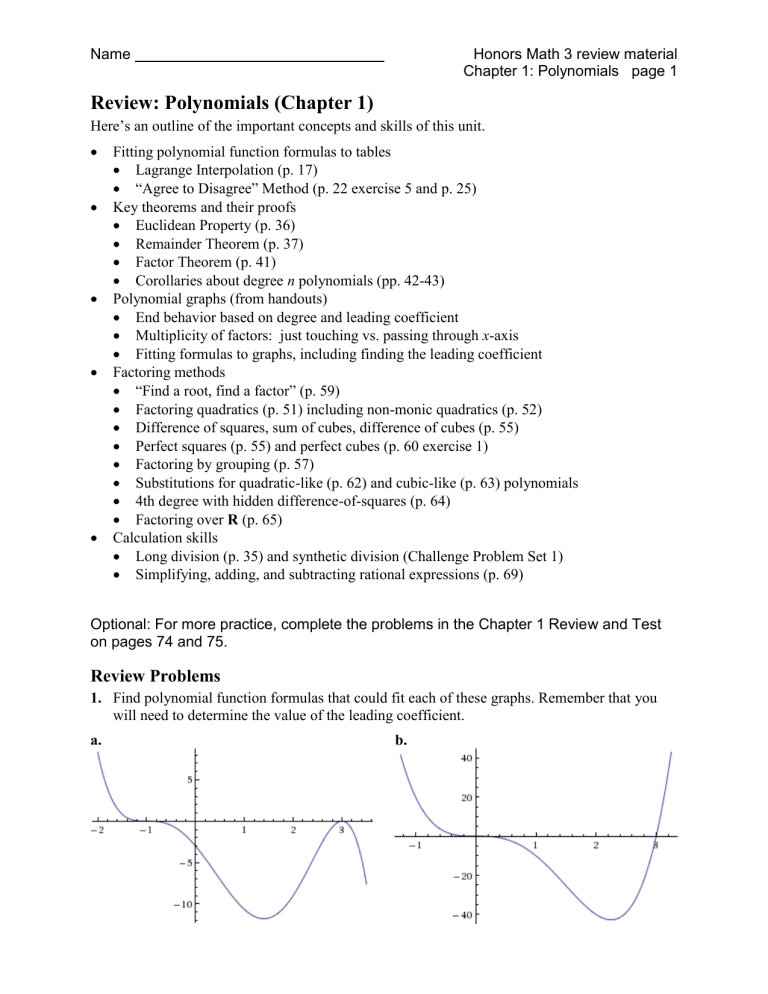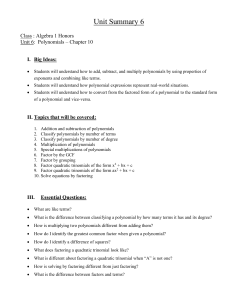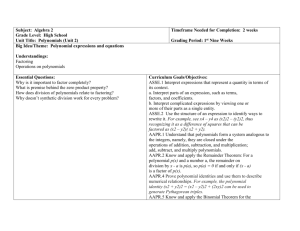Review: Polynomials (Chapter 1)

Name Honors Math 3 review material
Chapter 1: Polynomials page 1
Review: Polynomials (Chapter 1)
Here’s an outline of the important concepts and skills of this unit.
Fitting polynomial function formulas to tables
Lagrange Interpolation (p. 17)
“Agree to Disagree” Method (p. 22 exercise 5 and p. 25)
Key theorems and their proofs
Euclidean Property (p. 36)
Remainder Theorem (p. 37)
Factor Theorem (p. 41)
Corollaries about degree n polynomials (pp. 42-43)
Polynomial graphs (from handouts)
End behavior based on degree and leading coefficient
Multiplicity of factors: just touching vs. passing through x -axis
Fitting formulas to graphs, including finding the leading coefficient
Factoring methods
“Find a root, find a factor” (p. 59)
Factoring quadratics (p. 51) including non-monic quadratics (p. 52)
Difference of squares, sum of cubes, difference of cubes (p. 55)
Perfect squares (p. 55) and perfect cubes (p. 60 exercise 1)
Factoring by grouping (p. 57)
Substitutions for quadratic-like (p. 62) and cubic-like (p. 63) polynomials
4th degree with hidden difference-of-squares (p. 64)
Factoring over R (p. 65)
Calculation skills
Long division (p. 35) and synthetic division (Challenge Problem Set 1)
Simplifying, adding, and subtracting rational expressions (p. 69)
Optional: For more practice, complete the problems in the Chapter 1 Review and Test on pages 74 and 75.
Review Problems
1.
Find polynomial function formulas that could fit each of these graphs. Remember that you will need to determine the value of the leading coefficient. a. b.
Name Honors Math 3 review material
Chapter 1: Polynomials page 2
2.
The grid below shows a portion of the graph of a 6th degree polynomial, f ( x ). There may be additional x -intercepts that can’t be seen in this graphing window. a.
From the graph, list all of the factors of f ( x ) that can be determined. b.
What is the remainder when f ( x ) is divided by ( x – 1)? c.
How many x-intercepts might f(x) have?
Consider what the graph of f ( x ) might look like in a larger graphing window. In each of the boxes below, sketch a possible graph having the specified number of x -intercepts, or write impossible if that number of x -intercepts is not possible.
2 x -intercepts 3 x -intercepts 4 x -intercepts 5 x -intercepts 6 x -intercepts d.
Now, for the cases that you said were impossible , justify your answer.
3.
Suppose that R ( x ) is a polynomial of degree 5 . Answer the following questions about R ( x ).
You do not have to explain why your answers are true. a.
List the possibilities for the number of turning points (or U-turns, or maxima/minima) that the graph of R ( x ) could possibly have? b.
List the number of distinct real zeros that R ( x ) could possibly have?
Note:
x
3
2
x
5
3
has two distinct zeros c.
If R ( x ) is divided by ( x – k ), what will the remainder be?
Name Honors Math 3 review material
Chapter 1: Polynomials page 3 f ( x )
4.
Suppose that a polynomial division problem g ( x )
has a quotient q ( x ) with remainder r ( x ). a. How is the degree of r ( x ) related to the degree of one of the other polynomials? b. Find an expression for f (–3) in terms of the other polynomials in this problem. c.
Suppose that g ( x ) = x + 3. Without citing “Remainder Theorem” as a reason, prove that the remainder for x f (
x )
3
equals f (–3). d.
Now suppose that g ( x ) = x + 3 and f ( x ) = 4 x
3
– 7 x
2
+ 10. Divide to find q ( x ) and r ( x ).
5 a. Suppose f ( x )
4 x
3 x
2
3 x
1 . Use the remainder theorem to show that f ( x ) – f (2) is divisible by x – 2.
b. Generalize: Prove for any polynomial f ( x ) that f ( x ) – f ( a ) is divisible by x – a .
6. Find the value of k, such that x + 3 is a factor of: a.
x
3 kx
2
2 x
6 b. kx
3
2 x
2 x
6
7. Factor each polynomial over Z . a.
c.
2 x
4
9 x
2
18
2 ax
bx
2 ay
by b.
x
4
3 x
2
4 d.
8 x
3 y
3
4 x
2 y
2 e.
x
12
1 f.
x
4
64
8.
Factor this polynomial over R : x
3 x
2
8 x
6 .
9.
Find all real-number solutions of the following equations using factoring. Check your answers on the calculator by graphing and using the zero command. a.
3 x
3
4 x
2
5 x
2
0 b.
27 x
3
8
0
10.
a.
Simplify:
27 x
3
9 x
2
1
1 b.
Subtract and simplify: x
5
4
27 x
3
9 x
2
1
1
11. Take it further. Suppose you define the function f ( x ) for nonnegative integers using the following recursive rule. f ( x )
1 f ( x
1 )
3 x
2 x
1 if if x x
0
0
Find a polynomial function, in standard form, that agrees with f ( x ) on its domain.
Name Honors Math 3 review material
Chapter 1: Polynomials page 4
Review Problem Answers
These are first-draft answers. If anything doesn’t look right, please discuss with your teacher.
1.
Here are possible answers. It’s OK if your leading coefficients are slightly off. a.
f ( x )
1
3
( x
1)
3
( x
3)
2
using (0, –3) b.
f ( x ) = 5x
3
( x – 3) using (2, –40)
2. a. x 2 , ( x – 3) b. f (1) = 2 c.
Graphs with 3, 4, and 5 x -intercepts are all possible. (To get 4 x -intercepts you’ll need to include another “just touching” x -intercept.) d.
Having just 2 x -intercepts is impossible because 6th degree end behavior must be up on both sides or down on both sides, so the graph must cross the x -axis a third time.
Having 6 x -intercepts is impossible because they would produce 6 linear factors, but at x = 0 there is even multiplicity so there would have to be a 7th factor (another x
), and it’s impossible for a 6th degree polynomial to have 7 linear factors.
3.
a.
0, 2, or 4 b.
1, 2, 3, 4, or 5 c.
R ( k ) (by the Remainder Theorem)
4.
a.
deg r ( x ) < deg g ( x
). (If it weren’t, you could continue dividing.) b.
f (–3) = g (–3) q (–3) + r (–3) from the Euclidean Property. c.
Since g ( x ) is linear, the remainder must be a constant R . The equation from part b becomes f (–3) = (–3 + 3) q (–3) + R = 0 + R = R , proving that f (–3) is the remainder. d.
q ( x ) = 4 x
2
– 19 x + 57, r ( x ) = –161.
5.
a.
Given f ( x )
4 x
3 x
2
3 x
1 , f ( x )
f ( 2 )
4 x
3 x
2
3 x
30 . When substituting 2 for x , the result is 0. So, f ( x ) – f (2) is divisible by x – 2. b.
The Euclidean Property applied to f ( x ) x
a
gives that f ( x ) = ( x – a ) q ( x ) + remainder.
By the Remainder Theorem, the remainder is f ( a ), so f ( x ) = ( x – a ) q ( x ) + f ( a ).
Subtract f ( a ) from both sides to get f ( x ) – f ( a ) = ( x – a ) q ( x ) which has ( x – a ) as a factor.
6.
a.
k = 3 b.
k = –1
7. a.
2 x
2
3
x
2
6
b. c.
2 a
b
x
y
d.
x
2 x
2
x
2 x
2
2 x
y
4 x
2
2 xy
2 x
y
y
2
e. f.
( x
( x x
2
1)( x
2
4 x
8
x
x
2
1)(
x
4
x
1)(
8 x
2 x
1)( x
2
3 )( x
1
3 )( x
1
3 )
1)( x
4 x
2
1)
8.
9.
a.
1, –1/3, and –2 b.
2/3 (the quadratic factor does not have real zeros)
10.
Answers apply for x
1
3
: a.
9 x
2
3
3 x x
1
1 b.
9 x
3
33 x
2
26 x
9
(3 x
1)( x
4)
11.
x
3
+ x
2
+ x + 1









